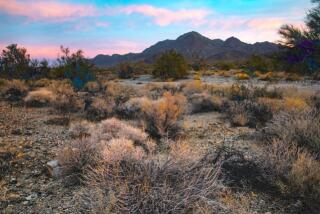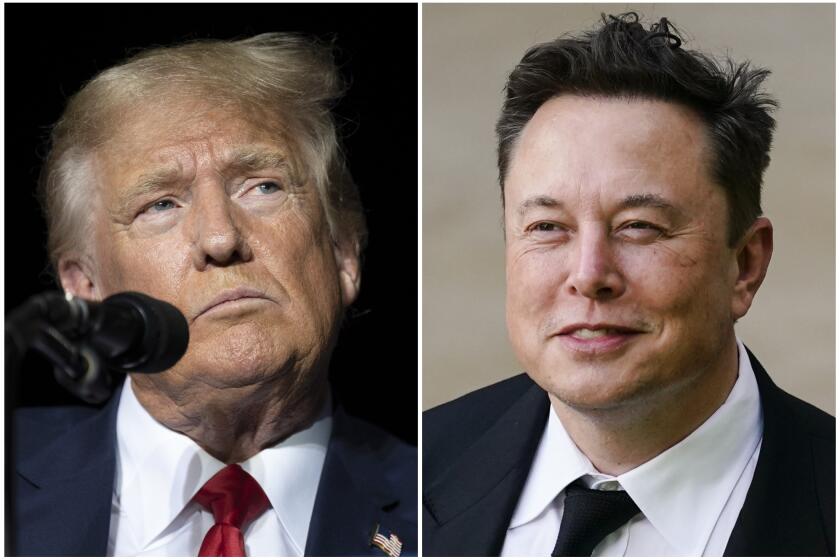Amid Giants, Bush Airs His Park Plan
- Share via
SEQUOIA NATIONAL PARK, Calif. — President Bush pledged Wednesday to repair the national parks with the savvy of the business world and a dedication to “a new environmentalism for the 21st century.”
In his first presidential speech on the environment, Bush outlined a course under which the federal government would share responsibility for protecting the environment with state and local authorities, citizens and private groups.
“We must protect the claims of nature while also protecting the legal rights of property owners,” he said. The president used the morning in Sequoia National Park to draw attention to the request he made in this year’s budget proposal for a $4.9-billion, five-year program to eliminate the backlog of deferred maintenance. The administration will use the money to repair roads and trails, visitor centers, and water and sewage treatment systems, among other projects, while holding off purchases of land to expand the park system.
Bush also said the Interior Department would prepare an annual report on the state of the nation’s parks and begin annual examinations of each park’s needs, bringing in outside consultants to study conditions and requirements.
By “getting MBAs involved,” said White House Press Secretary Ari Fleischer, “you can have a business sense that complements very nicely the work of the federal government.”
Visit to the Sierra Wraps Up State Visit
Bush literally wrapped himself in green for the occasion: He wore a shiny green jacket bearing the National Park Service emblem over an olive green shirt as he strolled through the groves of sequoias, the monarchs of the forest.
The excursion in the Sierra was Bush’s final stop in a two-day visit to California, his first time in the state since taking office as president four months ago.
The overnight stay in Sequoia--Bush spent Tuesday night at a park lodge--topped with a climb up 400 steps to the summit of Moro Rock, a park landmark, reflected a continuing effort by the White House to present Bush as sympathetic to environmental concerns. Next week he is expected to speak about the Everglades during a visit to Florida.
Since taking office in January, Bush has moved to reverse a number of the Clinton administration’s environmental policies. He rejected the global warming treaty negotiated in Kyoto, Japan; suspended new arsenic standards for drinking water; and reversed a campaign pledge to reduce carbon dioxide emissions.
But he also has upheld several environmental regulations, including restrictions on lead contamination and wetland development. On Tuesday, his administration said it would move to reduce air pollution in the national parks.
A CNN/Time poll last week found that 42% of those surveyed thought Bush was doing a good job protecting the environment and 43% thought he was doing a bad job.
The morning in the clear air of the mountains served as a crisp political counterpoint to the hard edge of Bush’s energy order, particularly sensitive in California: Conserve but develop more resources through aggressive exploration for oil and gas, and open the Arctic National Wildlife Refuge for oil and gas production.
Bush, in black cowboy boots, spent 10 minutes climbing to the top of Moro Rock, which affords a view deep into the San Joaquin Valley--when ozone levels permit--and high up to the 13,000-foot peaks of the Sierra Nevada range.
Atop the granite dome, his brow wet with perspiration, his jacket shed and his sleeves rolled up, he declared: “It’s something else up here, isn’t it?”
Later, the president--positioned in a telegenic way with the park’s Sentinel sequoia just over his shoulder--spoke to about 150 park employees and their families brought by bus to the grove.
Marveling at the age of the trees, Bush said they were standing when the Mayflower brought the Pilgrims across the Atlantic, when the Roman empire fell, and when it rose.
“Had Christ himself stood on this spot, he would have been in the shade of this very tree,” Bush said, sounding winded after the exercise at the 6,800-foot elevation.
The tree, 257 feet tall and 86 feet around at its base, is 2,100 to 2,200 years old, “give or take a few centuries,” said Malinee Crapsey, a park ranger.
‘Our Duty Is to Use the Land Well’
Outlining his plans to repair the parks, Bush said, “Many parks have gone years without receiving the kind of care and upkeep the American people expect.
“Our duty is to use the land well and, sometimes, not to use it at all.”
Reflecting the change in how the land is treated, William Tweed, a park ranger, said that sequoias were once cut down to protect the park’s hotel cabins--”until it was realized we were protecting the wrong things here.”
Environmentalists and park service employees have long cited the need to repair facilities that in many instances date to the New Deal work of the Civilian Conservation Corps during the 1930s.
The 3-square-mile Giant Forest Grove where Bush spoke is nearing completion of an approximately $75-million restoration project that was initially approved by the Jimmy Carter administration in 1980. Nearly 300 buildings have been removed, among them hotel cabins. A gift shop and a fast-food stand were remodeled into a visitor center for the park’s guests, which number about 1.3 million annually.
Bush was the first president to visit the 1,200-square-mile Sequoia National Park while in office, park officials said. But the area has been a popular one for presidents seeking to burnish their environmental credentials.
President Clinton visited the adjacent Sierra National Forest last year, and Bush’s father visited the forest in 1992 just as the Democratic Party was about to nominate Al Gore, a senator supported by environmentalists, as their vice presidential candidate.
Explaining the decision to put $4.9 billion into park rehabilitation rather than to protect more land, administration officials were skittish about calling the halt in park expansion a freeze.
“It’s a question of whether we should pay our existing bills or go on a shopping spree,” said Interior Secretary Gale A. Norton, who accompanied Bush on Wednesday.
But Fleischer acknowledged that there were no plans to expand the park system’s land.
More to Read
Get the L.A. Times Politics newsletter
Deeply reported insights into legislation, politics and policy from Sacramento, Washington and beyond. In your inbox twice per week.
You may occasionally receive promotional content from the Los Angeles Times.










